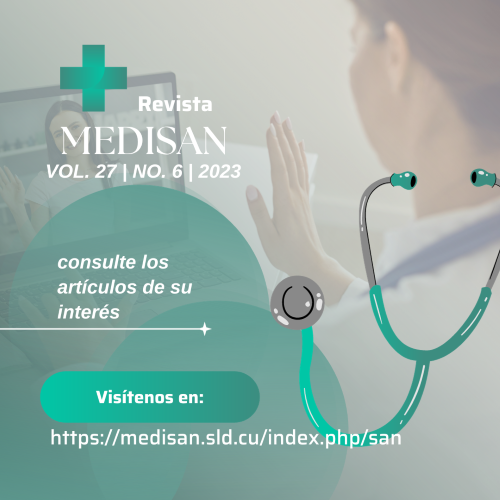Risk factors and comorbidities in patients with grade I and II acne vulgaris
Keywords:
acne vulgaris, risk factors, comorbidities, secondary health care.Abstract
Introduction: Common acne is the most frequent disease in adolescents and young adults; it constitutes a chronic obstructive and inflammatory state of pilosebaceous follicles, characterized by the formation of inflammatory lesions.
Objective: To identify the risk factors and comorbidities associated to grade I and II common acne and its psychosocial impact.
Methods: An observational, descriptive and cross-sectional study of 50 patients with grade I-II common acne was carried out; they were assisted at Dr. Juan Bruno Zayas Alfonso Teaching General Hospital in Santiago de Cuba, from January, 2018 to the same period in 2020. The risk factors and comorbidities associated with the dermatoses were valued, as well as the onset time of them.
Results: In the series there was a prevalence of the 18-24 age group and the female sex (60.0%, respectively), the anxiety (58.0%), seborrheic state of the skin and toxic habits (44.0% each one). Also, the school level of technician and mixed race (60.0% each one), accompanied as marital status (44.0%), the urban origin (88.0%), as well as those affected with evolution of the disease between 4 to 12 months, without family pathological history, as well as endocrine disorders as the comorbidities associated with the dermatoses.
Conclusions: A great part of the patients presented, as risk factors, some emotional event of anxiety and seborrheic state of the skin related to the acne, which were associated with endocrine-metabolic comorbidities.
Downloads
References
2. Díaz García MA. Dermatitis seborreica, acné vulgar y rosácea. En: Manzur Katrib J, Díaz Almeida JG, Cortés Hernández M, Ortiz González PR, Sagaró Delgado B, Abreu Daniel A. Dermatología. La Habana: Editorial Ciencias Médicas; 2002. p. 114-8 [citado 27/05/2023]. Disponible en: http://bvs.sld.cu/libros_texto/dermatologia/dermatologia.pdf
3. Morales Flores MX, Paniagua Muñoz JA. Elección del mejor tratamiento para el acné activo y sus cicatrices en Medicina Estética [tesis]. Barcelona: Universidad de Barcelona; 2018 [citado 27/05/2023]. Disponible en: https://www.semcc.com/master/files/Tratamiento%20acne%20-%20Dres.%20Morales%20y%20Paniagua.pdf
4. Muñoz Parody Armando JC, Gulfo Gutierrez J. Prevalencia de baja autoestima en adolescentes con acné: Revisión Sistemática [tesis]. Barranquilla: Universidad del Norte; 2019 [citado 27/05/2023]. Disponible en: https://manglar.uninorte.edu.co/bitstream/handle/10584/9094/139724.pdf?sequence=1&isAllowed=y
5. Torres Fajardo ME, Zumba Vásquez JJ. Consecuencias del acné en la autoestima y autoconcepto en adolescentes. Colegio Santa Mariana de Jesús, 2017 [Proyecto de Investigación previa a la obtención del Título de Licenciado en Enfermería]. Cuenca: Universidad de Cuenca; 2018. [citado 27/05/2023]. Disponible en: http://dspace.ucuenca.edu.ec/bitstream/123456789/29357/1/PROYECTO%20DE%20INVESTIGACI%c3%93N.pdf
6. Castellanos Orozco V, Herrera Quiroz JJ, Mezquida Díaz LC, Molina Díaz MJ, Pérez Castro JC, et al. Depresión y ansiedad en jóvenes con acné vulgar de consulta externa del hospital universidad del norte. Abril- mayo 2022 [tesis]. Barranquilla: Universidad del Norte; 2022 [citado 27/05/2023]. Disponible en: https://manglar.uninorte.edu.co/bitstream/handle/10584/10809/1010132664.pdf?sequence=1&isAllowed=y
7. Cabrera Salaberri CM, González González ML, González Lastra S. Estudio sobre incidencias de acné y factores agravantes psicosociales en estudiantes de medicina [tesis]. Tenerife Islas Canarias: Universidad de La Laguna; 2020 [citado 27/05/2023]. Disponible en: https://riull.ull.es/xmlui/bitstream/handle/915/20309/%BFEstudio%20sobre%20incidencias%20de%20acne%20y%20factores%20agravantes%20psicosociales%20en%20estudiantes%20de%20medicina%BF.pdf;jsessionid=BD448B4A6FB8A6F20D4BDAD2219905AA?sequence=1
8. Rueda LJ, Porras A, Rico A. Prevalence of adult female acne in Colombia: A population-based study. Int J Women's Dermatology. 2021 [citado 27/05/2023];7(5):727-30. Disponible: https://www.sciencedirect.com/science/article/pii/S2352647521000733
9. Heng AHS, Chew FT. Systematic review of the epidemiology of acne vulgaris. Sci Rep. 2020 [citado 27/05/2023];10(5754). Disponible en: https://www.nature.com/articles/s41598-020-62715-3
10. Bocio Bonet M, Corball MV, Garay IS, Valente E, Ruiz Lascano A. Epidemiología e impacto en la calidad de vida de los pacientes con acné juvenil. Piel. 2023 [citado 27/05/2023];38(2):83-8. Disponible en: https://www.sciencedirect.com/science/article/abs/pii/S0213925122002192
11. Nakamizo S, Honda T, Kabashima K. Obesity and inflammatory skin diseases. Trends Immunother. 2019 [citado 27/05/2023];3(1):50-7. Disponible en: https://www.researchgate.net/publication/350379649_Obesity_and_inflammatory_skin_diseases
12. Melnik BC. Acne vulgaris: The metabolic syndrome of the pilosebaceous follicle. Clin Dermatol. 2018 [citado 27/05/2023];36(1):29-40. Disponible en: https://www.sciencedirect.com/science/article/abs/pii/S0738081X1730161X
13. Öztekin C, Öztekin A. The association of depression, loneliness, and internet addiction levels in patients with acne vulgaris. Biopsychosoc Med. 2020 [citado 27/05/2023];14:17. Disponible en: https://www.ncbi.nlm.nih.gov/pmc/articles/PMC7405352/
14. Elsadek S, Obaid Z, Hashem O, Abdelmaksoud A. Psychological effects of acne vulgaris among secondary school adolescents in Damietta Governorate. Int J Med Arts. 2021 [citado 27/05/2023];3(1):1163-71. Disponible en: https://ijma.journals.ekb.eg/article_136507_ea8e408d8bcee539b7b9db37ec95ccb1.pdf
15. Pantoja Villa LF, Medina Castillo DE, Avilés Sánchez ME. Depresión y calidad de vida en pacientes con acné al inicio y al final del tratamiento. Dermatología Rev Mex. 2019;63(2):123-43.
16. Baldwin H, Tan J. Effects of Diet on Acne and Its Response to Treatment. Am J Clin Dermatol. 2021 [citado 27/05/2023];22(1):55-65. Disponible en: https://www.ncbi.nlm.nih.gov/pmc/articles/PMC7847434/
17. Chen H, Zhang TC, Yin XL, Man JY, Yang XR, Lu M. Magnitude and temporal trend of acne vulgaris burden in 204 countries and territories from 1990 to 2019: an analysis from the Global Burden of Disease Study 2019. Br J Dermatol. 2022;186(4):673-83.
18. Iglesia Pena N. Acné en la adolescencia. ADOLESCERE. 2022 [citado 27/05/2023];10(1):5-14. Disponible en: https://www.adolescere.es/revista/pdf/volumen-X-n1-2022/2022-n1-05-14_Tema-de-revision-Acne-en-la-adolescencia.pdf
19. Chavarría Laguna BA. Eficacia del tratamiento con dapsona oral en relación al tratamiento convencional en pacientes con acné inflamatorio moderado-severo atendidos en el Centro Nacional de Dermatología, Abril 2018-Febrero 2019 [tesis]. Managua: Universidad Nacional Autónoma de Nicaragua; 2019 [citado 27/05/2023]. Disponible en: https://repositorio.unan.edu.ni/11061/1/100.109.pdf
20. Balón Quimí EM, Rodríguez Pozo JA. Efectos del peloide y la sábila en adolescentes con acné vulgar. Centro de Salud Santa Rosa-Salinas 2018 [tesis]. La Libertad: Universidad Estatal Península de Santa Elena; 2018 [citado 27/05/2023]. Disponible en: https://repositorio.upse.edu.ec/xmlui/bitstream/handle/46000/4534/UPSE-TEN-2018-0035.pdf?sequence=1&isAllowed=y
Published
How to Cite
Issue
Section
License
All the articles can be downloaded or read for free. The journal does not charge any amount of money to the authors for the reception, edition or the publication of the articles, making the whole process completely free. Medisan has no embargo period and it is published under the license of Creative Commons, International Non Commercial Recognition 4.0, which authorizes the copy, reproduction and the total or partial distribution of the articles in any format or platform, with the conditions of citing the source of information and not to be used for profitable purposes.





